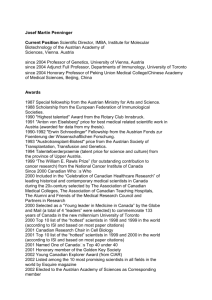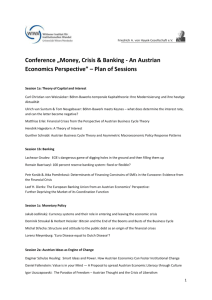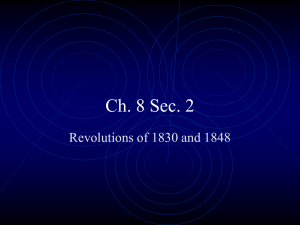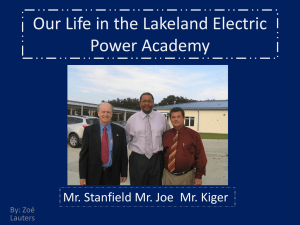Presentation
advertisement
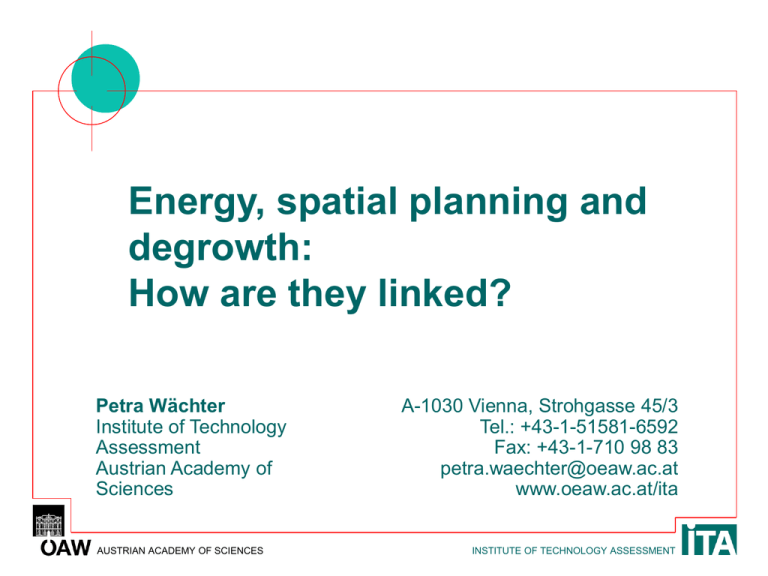
Energy, spatial planning and degrowth: How are they linked? Petra Wächter Institute of Technology Assessment Austrian Academy of Sciences AUSTRIAN ACADEMY OF SCIENCES A-1030 Vienna, Strohgasse 45/3 Tel.: +43-1-51581-6592 Fax: +43-1-710 98 83 petra.waechter@oeaw.ac.at www.oeaw.ac.at/ita INSTITUTE OF TECHNOLOGY ASSESSMENT Overview Introduction Energy in Neoclassical Theory Aiming at energy degrowth Energy and land use o Competition between different renewable energy resources o Competition between energy and food Role of spatial planning institutions Conclusions AUSTRIAN ACADEMY OF SCIENCES INSTITUTE OF TECHNOLOGY ASSESSMENT Introduction Reliance on energy consuming activities in production and consumption is one of the pillars of each economic system Paradigm of economic growth is still main goal for policy-makers worldwide Indicator for Growth: Gross Domestic Product (GDP) AUSTRIAN ACADEMY OF SCIENCES INSTITUTE OF TECHNOLOGY ASSESSMENT Energy in Neoclassical Theory Cobb-Douglas production function: Yt = AtLtß1tKtß2tEtß3t β1t + β2t + β3t = 1 …implies substitution between input factors …means scarcity in energy sources does not harm any production activity as long as exist options for substitution with other input factors AUSTRIAN ACADEMY OF SCIENCES INSTITUTE OF TECHNOLOGY ASSESSMENT What does GDP not measure? GDP measures flows of goods and services but not the stock! Ecological factors: o damages on ecosystem: environmental harms on air, water, land, forests and whole fauna and flora o E.g. depletion of non renewables energy resources contributes to a rise in GDP and is not seen as a depreciation of natural capital; compensation for negative externalities Social factors: no reflection on who benefits from production and consumption; no measurement of equity, social capital or immaterial goods; no reflection of any kind of risks, e.g energy security Economic factors: no measurement of economic transactions and activities outside of economic market, e.g. work in households, black labour market GDP does not measure sustainable growth! AUSTRIAN ACADEMY OF SCIENCES INSTITUTE OF TECHNOLOGY ASSESSMENT Empirical estimates on the causal relationship between energy and economic growth Four possible directions: o No causality at all (neutrality hypothesis) o Economic growth causes energy consumption (conservation hypothesis) o Energy consumption causes economic growth (growth hypothesis) o Mutual relationship (feedback hypothesis) No empirical evidence for any of these hypotheses! Manifold discussion if energy is adequately represented in neoclassical production functions AUSTRIAN ACADEMY OF SCIENCES INSTITUTE OF TECHNOLOGY ASSESSMENT Aiming at a degrowth of energy consumption Energy use is restricted by the two laws of thermodynamic! Increased energy-efficiency within a growth paradigm postpones resource scarcity (restricted by reboundeffect!) Current energy use is no longer affordable due to irreversible damages to ecosystem Non-renewable as well as renewable energy resources have large impacts on local, regional and global levels (atmospheric pollution, loss of biodiversity, destruction of land) AUSTRIAN ACADEMY OF SCIENCES INSTITUTE OF TECHNOLOGY ASSESSMENT Energy and land use Mutual relationship: Energy use has impacts on land use AND use of land determines energy consumption Constraints of use of renewable energy due to limited available land and to limited biophysical capacities Land use conflicts: o Competition between different energy sources o Competition between agricultural and energy use AUSTRIAN ACADEMY OF SCIENCES INSTITUTE OF TECHNOLOGY ASSESSMENT Overuse of energy resources Availability of land is limiting factor for not using renewable energy resources endlessly! Impacts: Failure to comply with sustainability standards has severe consequences on fauna and flora, the ecosystem, losses of biodiversity (e.g. erosion of land by planting monocultures of trees or crops for energy purposes, excessive water use) Resistance of local population: e.g. wind mills: noisy, landscape disfiguring hydro power plants: loss of living space and cultural heritage for thousands of people, e.g. China, Turkey (dam of Ilisu) Use regional and local conditions regarding possibilities to produce energy sustainably AUSTRIAN ACADEMY OF SCIENCES INSTITUTE OF TECHNOLOGY ASSESSMENT Food and energy – competing functionalities Main pressure: population growth leading to increased food demand Renewable energy crops tend to crowd out food crops rise in price level for food Severe consequences for population Higher investments in agricultural production because of higher demand of biofuels increasing profit possibilities Therefore, diminishing demand for biofuels would enhance global food security AUSTRIAN ACADEMY OF SCIENCES INSTITUTE OF TECHNOLOGY ASSESSMENT Crucial role of spatial planning institutions Decisions about dedication of land use: Regions specific energy use: incorporating sustainability criteria Settlement structures: decisions about the location of settlements and industries, and its related infrastructures, strength of different economic circles Transport system: enhance sustainable mobility behaviour with a strong reliance on public transport, secure mobility without a growing individualised transport AUSTRIAN ACADEMY OF SCIENCES INSTITUTE OF TECHNOLOGY ASSESSMENT Conclusions No empirical results of the relationship between GDP and energy use energy is not adequately reflected Current energy demand is not feasible with renewable energy resources that should meet standards of sustainability criteria Limitation of unlimited energy use leads to a pressure of production and consumption that will unavoidably lead to lower levels of economic activity Crucial role of spatial planning institutions: Long term energy security must take place in line of sustainable land use Degrowth of non-renewable but also of renewable energy resources!!! AUSTRIAN ACADEMY OF SCIENCES INSTITUTE OF TECHNOLOGY ASSESSMENT
